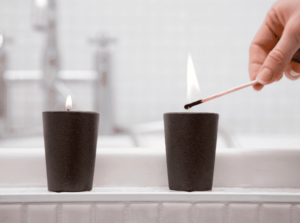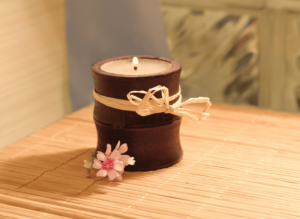Do you ever stop to consider the latent threats that surround you within your home, threats that have the significant potential to compromise your indoor air quality drastically? The smallest, most inconspicuous of items found within an indoor environment have the potential to be a possible hazard to the quality of your indoor air. Sources of pollution that can be emitted indoors can come from a wide variety of miscellaneous items including everyday cleaning products, recently installed hardwood floors, and even the candles that are found scattered throughout your home that you on-occasion, or maybe even every day, light to produce the warm assembly of scents that will float throughout the home.
Candles are used in an array of fashions, such as for aromatherapy, ambiance, romance, décor, and for the aromatic fragrances that it emits into the air of the environment. Although the uses of candles can be endless, as are the options of different types, scents, and colors of candles that consumers can purchase. The dangerous truth is that the simple act of lighting a candle within your home can ignite the introduction of numerous airborne chemical contaminants into the air that will contribute to altered indoor air quality.
In this article we are going to discuss the hazards of candles to indoor air quality and learn alternatives and solutions to mitigating these potentially harmful chemicals from the air of your home.
Is Burning Candles Bad for You?
 Over the last few years the topic of burning candles in indoor environments has gained notable attention, as the Environmental Protection Agency has stepped in to provide testing on the emissions produced from candles in an attempt to determine the risk levels when used in these environments. Candles are made in a variety of ways and can be manufactured using different chemical ingredients within its composition that can present different hazards into the air. One of the biggest issues at the forefront with candles are those candles that contain parabens and VOCs that will lead to dangerous emissions upon the burning of the candle.
Over the last few years the topic of burning candles in indoor environments has gained notable attention, as the Environmental Protection Agency has stepped in to provide testing on the emissions produced from candles in an attempt to determine the risk levels when used in these environments. Candles are made in a variety of ways and can be manufactured using different chemical ingredients within its composition that can present different hazards into the air. One of the biggest issues at the forefront with candles are those candles that contain parabens and VOCs that will lead to dangerous emissions upon the burning of the candle.
Of the different options of candles, scented candles are among a favorite for consumers – as this type of candle has grown in both popularity and use throughout the years. According to the National Candle Association (NCA) it was found that about seventy-five percent of the manufacturers who are a part of their association listed fragranced candles among the types of candles they produce. When these candles are burned, however, they can emit trace amounts of organic chemicals into the air space, this will include acetaldehyde, formaldehyde, acrolein, and naphthalene – which can produce hazardous health effects from increased levels of exposure in the air.
What are Scented Candles Made of?
The composition of your candles is something that often is not considered prior to purchase, however, it really should be. There are many ingredients that candle manufacturers use that can be hazardous to human health and greatly impact indoor air quality. The type of wax that is used in candles is a major source of potential airborne pollution, as there are a wide range of candle waxes that are known to be carcinogenic when burned within an indoor environment. Of these toxic waxes that need to be avoided when purchasing candles is a wax known as paraffin.
Paraffin is a wax that’s ingredients are derived from petroleum – and will have the potential of emitting toluene and benzene into the air, which are known human carcinogens (cancer-causing agents). A recent study that was presented at the American Chemical Society’s national meeting in 2009 found that cancerous toxins were given off by paraffin-based candles, according to Dr. Ruhuallah. These cancer-causing agents emitted from paraffin wax candles can lead to brain, lung, and central nervous system damage, along with other development difficulties.
Why Are Candles Bad for Indoor Air Quality?
When it comes to candles, there are many different factors that can contribute to elevated pollution levels emitted from the candle indoors. As we discussed earlier, the type of candle and candle wax that is used can significantly add to the pollution levels emitted into the indoor air of your home. However, there are other pollutants produced from candles that you also need to be worried about including particulate matter produced from soot that is emitted into the air from the wax used to construct the candle.
 In a study conducted by the Ernest Orlando Lawrence Berkeley National Laboratory, they found the following about candles and fine particulate matter (PM2.5) emission;
In a study conducted by the Ernest Orlando Lawrence Berkeley National Laboratory, they found the following about candles and fine particulate matter (PM2.5) emission;
“In additional to cooking activities, indoor combustion activities such as candle burning also generated significant PM2.5. Glytsos et al. reported that candle burning has significant particle emission rates in the ultrafine range and will contribute to the elevation of indoor PM2.5 concentrations.”
Furthermore, the Environmental Protection Agency stated that exposure to particles smaller than 10 micrometers in diameter pose the greatest problems and can travel deep into your lungs and enter the bloodstream.
The EPA stated that the following symptoms can be exacerbated by PM2.5 exposure:
- Premature death in people with heart or lung disease
- Nonfatal heart attacks
- Irregular heartbeat
- Aggravated asthma
- Decreased lung function
- And increased respiratory symptoms, such as irritation of the airways, coughing, or difficulty breathing
Harmful Chemicals Used in Candles
As we discussed earlier, a number of organic compounds (some labeled Volatile Organic Compounds – VOCs) have been found to be present and emitted from burning candles in an indoor environment. Volatile organic compounds are emitted gases that come from certain solids and liquids that will form into a gaseous compound at ambient temperatures. These gaseous compounds have been identified as a primary source of pollution indoors, contributing to the EPA’s findings that organic compound levels in indoor air is usually 2 to 5 times higher than outside of the home.
Among the organic compounds that are commonly found in many consumer candles includes acetaldehyde, formaldehyde, and acrolein – all of which can lead to compromised air quality and potential effects to human health from exposure. Formaldehyde, in particular, can enter into your indoor environment through a multitude of items including upholstery, furniture, cabinets, flooring, and even candles. According to the Agency for Toxic Substances and Disease Registry, “Most people don’t have any health problems from small amounts of formaldehyde, rather increased levels of formaldehyde exposure can elicit breathing problems, along with irritation to the eyes, nose, throat, and skin”. This illustrates the potential dangers that lurk from having moderate to high levels of VOCs in your indoor air, some of which are emitted from the use of candles in the home.
Safe Candle Alternatives: Soy vs Beeswax Candles
 With more and more testing and studies being conducted on the dangers of certain types of candles, consumers are becoming more educated on the potential ingredients to avoid when purchasing products for their home. Safer candle alternative has been created and manufactured to the public including the popular soy and beeswax candles that many are flocking to that contain far less dangers than traditional paraffin wax candles. However, is there a better option between soy candles and beeswax candles? This has been a debated topic, as consumers try to determine which type of candle is the best to use inside of their homes.
With more and more testing and studies being conducted on the dangers of certain types of candles, consumers are becoming more educated on the potential ingredients to avoid when purchasing products for their home. Safer candle alternative has been created and manufactured to the public including the popular soy and beeswax candles that many are flocking to that contain far less dangers than traditional paraffin wax candles. However, is there a better option between soy candles and beeswax candles? This has been a debated topic, as consumers try to determine which type of candle is the best to use inside of their homes.
Soy candles are candles that are made from soy wax, a wax that is processed from soybean oil. This type of candle is a long-lasting candle that burns more slowly than that of paraffin wax. Additionally, soybeans are natural candle waxes that produce much less smoke than other types of candle waxes.
Beeswax candles are an all-natural, non-toxic waxy substance that is secreted by bees after they consume honey. This type of candle wax has become a highly popular form of candle wax due to its lower toxicity, that produces less soot and has minimal traces of chemicals known to be carcinogenic.
How to Restore Indoor Air Quality After Toxic Candle Emissions
Indoor air quality is highly important, as the Environmental Protection Agency found that most Americans spend close to 90 percent of their time indoors – and when increased levels of pollution is present in this space it can significantly impact health. If you have used toxic chemicals within your home, there may be elevated levels of pollution including particulate matter and VOCs present in the air, both of which can taint your indoor air quality and lead to the exacerbation of certain health issues.
Some of the most effective ways to improve your indoor air quality and reduce source of pollution from the air is through air filtration, which is highly effective in air purification systems. Air purifiers are designed to filter the indoor air of contaminants and pollutants and assist in maintaining the quality of the indoor air inside of your home.
Air Purifier for Removing Candle Soot Particulates & VOCs
 Many air purifiers utilize traditional air purifier technologies (ozone, ionizers, and carbon), that deploy either aggressive chemistries or simply work to capture the airborne pollutants rather than neutralizing and breaking them down, and when it comes to VOCs a more complete mechanism will be critical for your air quality. The EnviroKlenz Air Purifier, unlike other air purifiers, is a great solution for removing VOCs from your indoor air through the use of a patented earth mineral technology that is proven to actually contain and neutralize a broad spectrum of noxious and toxic chemicals and odors, along with capturing fine particulate matter that can be found traveling in the air.
Many air purifiers utilize traditional air purifier technologies (ozone, ionizers, and carbon), that deploy either aggressive chemistries or simply work to capture the airborne pollutants rather than neutralizing and breaking them down, and when it comes to VOCs a more complete mechanism will be critical for your air quality. The EnviroKlenz Air Purifier, unlike other air purifiers, is a great solution for removing VOCs from your indoor air through the use of a patented earth mineral technology that is proven to actually contain and neutralize a broad spectrum of noxious and toxic chemicals and odors, along with capturing fine particulate matter that can be found traveling in the air.
The EnviroKlenz Air Purifier uses a two-stage filtration process, the first-stage is the patented EnviroKlenz technology for noxious and toxic odor and chemical removal (such as formaldehyde, acid gases, nitrogen compounds, and other organic compounds). The second-stage filtration is a hospital-grade HEPA filter that is capable of capture particulate matter 0.3 microns in size or larger from the air at a 99.99 percent efficiency, this will include soot particulate matter that is produced from toxic candle emissions in the indoor air.
Article Sources:
- United States Environmental Protection Agency: Candles and Incense as Potential Source of Indoor Air Pollution (link)
- Stanford University: Candles Causing Cancer (link)
- Ernest Orlando Lawrence Berkley National Laboratory: Compilation of Published PM5 Emission Rates for Cooking, Candles, and Incense for Use in Modeling of Exposures in Residences (link)
- United States Environmental Protection Agency (EPA): Health and Environmental Effects of Particulate Matter (PM) (link)
- United States Environmental Protection Agency (EPA): Volatile Organic Compounds’ Impact on Indoor Air Quality (link)
- Agency for Toxic Substances and Disease Registry (ATSDR): Formaldehyde in Your Home: What You Need to Know (link)
- United States Environmental Protection Agency (EPA): Indoor Air Quality (link)
Mobile Air System
✓ Patented earth mineral technology works to attack VOCs and break them down on a compound level
✓ No chemicals or masking agents
✓ Will not release any chemicals back into your environment
✓ Safer and faster at removing VOC’s than traditional carbon filters and PECO air purifiers
EnviroKlenz® Medical Disclaimer:
“Any information that is provided on this website is not for the use by any commercial or personal entity without expressed written consent of the blog author. The material and statements illustrated within this blog are not intended to diagnose, treat, cure, or prevent any diseases or medical conditions. Nor does the author in any way guarantee or validate the validity, totality, or efficacy of any claims and will therefore not be held responsible for the content of any claims. Always consult your medical physician for any specific medical advice or recommendations.”









